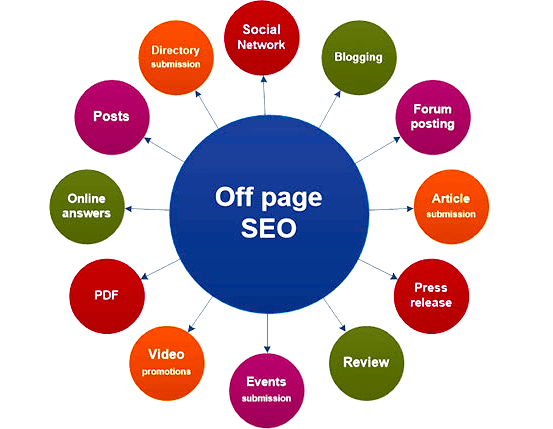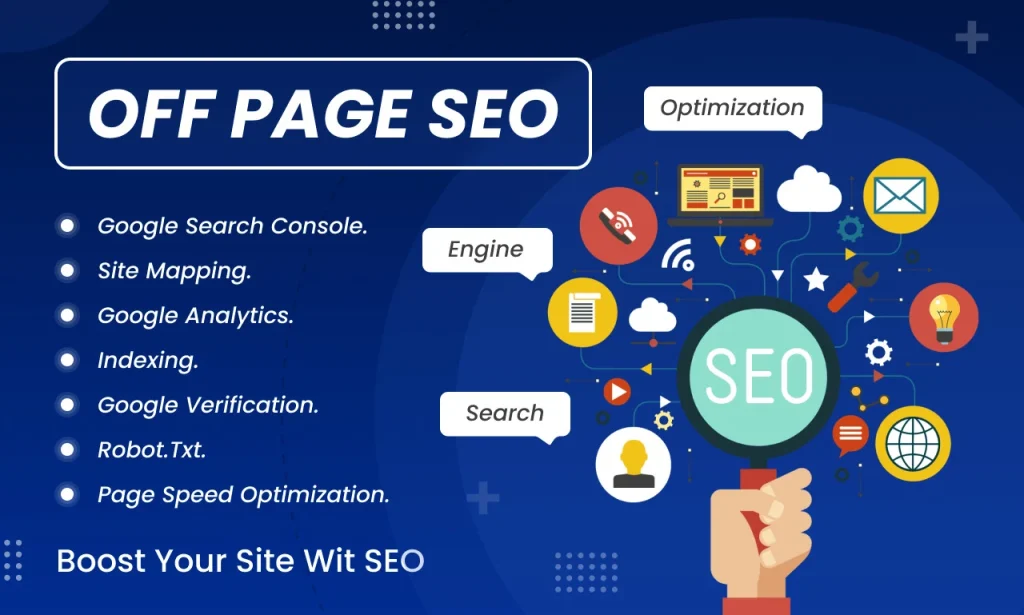Your Guide to Boosting Authority and Rankings
Off‑page SEO refers to optimization strategies implemented outside your own website to improve its visibility, authority, and rankings in search engines. Unlike on‑page SEO—which handles structure, content, and technical tweaks Off-Page SEO Service builds your site’s credibility through third‑party signals. In 2025, it remains a vital component of any comprehensive SEO strategy.
Off-Page SEO Service
-
Search Engine Trust & Authority
Google and other search engines interpret backlinks, social signals, and brand mentions as votes of confidence. High-quality third‑party validation tells engines your site is reputable—and deserving of higher rankings. -
Increased Visibility & Traffic
A presence on high-authority sites exposes your brand to fresh audiences. Quality backlinks can drive referral traffic—not just improve SERP performance. -
Competitive Edge
In niches crowded with content, strong off‑page SEO separates leaders from laggards. Great content backed by authority signals attracts sustained rankings and attention.

Key Components of Effective Off‑Page SEO
1. High-Quality Backlinks
Backlinks are the cornerstone of Off-Page SEO Service. But it’s not just about numbers—it’s about quality.
-
Relevance: Links from sites in your niche (or closely adjacent ones) matter more.
-
Authority: High-DR (Domain Rating) sites pass more link equity.
-
Contextual placement: Links within body copy carry more weight than footer/sidebar links.
-
Anchor text: Use natural, diverse anchor text to avoid over-optimization penalties.
-
Dofollow vs. nofollow: While nofollow links don’t pass page rank directly, they still contribute to a natural link profile.
Strategies to build links:
-
Guest posts on authoritative sites
-
Outreach campaigns (e.g., resource page links, broken‑link fixes)
-
Syndication with reputable platforms
-
Strategic partnerships and collaborations
2. Content Marketing & Promotion
Creating outstanding content is only half the battle—promotion is where visibility takes off.
-
Linkable assets: Develop original research, guides, tools, or infographics.
-
Outreach & PR: Pitch journalists, bloggers, and influencers who cover your industry.
-
Content syndication: Publish on platforms like Medium, LinkedIn, or relevant industry sites (with proper canonical links).
-
Digital PR campaigns: Launch surveys, data-driven stories, or interactive content pieces that news outlets and bloggers might reference.
3. Brand Mentions & Unlinked References
Search engines are getting smarter. Even unlinked mentions of your brand, product, or site across authoritative sources are recognized as credibility signals.
-
Monitoring tools: Track mentions using services like Google Alerts, Ahrefs Alerts, or Mention.
-
Outreach for links: When you find an unlinked mention, contact the webmaster to request proper attribution.
-
Brand image campaigns: Place mentions in interviews, podcasts, expert roundups, or social media to generate organic mentions.
4. Social Media Engagement
While social signals aren’t direct ranking factors, social platforms can amplify content and lead to backlinks.
-
Share-worthy content: Post useful tips, videos, and graphics tailored for each platform.
-
Engage proactively: Participate in industry groups, comment, answer questions, or join discussions.
-
Leverage influencers: Collaboration increases content reach and link acquisition potential.
-
Paid amplification: Ads or boosted posts targeting niche audiences can ignite organic shares and attention.
5. Influencer Outreach & Partnerships
Teaming up with influencers, thought leaders, or brands can result in valuable exposure and credibility.
-
Co‑created content: Webinars, podcasts, joint research, or guest blogs.
-
Testimonials & reviews: A quote from an influencer on your site (with a link back) adds both SEO and trust benefits.
-
Niche communities: Smaller-scale or micro‑influencers can be highly effective—especially in specialized or local markets.
6. Forums, Q&A & Community Participation
Your target audience is active on Reddit, Quora, StackExchange, industry forums, Facebook Groups, and LinkedIn communities.
-
Provide value: Answer questions, share resources, and demonstrate expertise—not just promote your brand.
-
Earn links naturally: When your contributions are helpful, users may follow to your site for more info.
-
Get indexed via evergreen threads: Popular Q&A threads often rank well long-term.
7. Local Citations & Directory Listings
For businesses targeting local customers, local Off-Page SEO Service signals are essential.
-
NAP consistency: Your business Name, Address, and Phone should be uniform across all listings.
-
Trusted directories: Register on Google Business Profile, Bing Places, Yelp, Yellow Pages, TripAdvisor (if relevant), industry-specific directories.
-
Reviews & ratings: Positive reviews on Google, Facebook, or niche review platforms enhance local visibility and trust.
Advanced Off‑Page SEO Techniques
1. Skyscraper & Ego-Bait Content
Skyscraper technique: Create the most comprehensive version of a topic, then reach out to sites linking to inferior versions.
Ego bait: Compile “top X influencers” lists or interviews designed to elicit sharing from those referenced.
2. HARO (Help a Reporter Out)
Platform connects journalists with expert sources.
Daily monitoring: Respond promptly to relevant queries.
Link attribution: If featured, you’ll typically receive a backlink in return.
3. Podcast Interviews & Guest Features
Podcasts and media interviews offer twofold benefits:
Backlinks from show notes
Exposure to engaged audiences
Find and pitch to podcasts in your niche—or launch your own.
4. Sponsorships, Scholarships & Donations
Supporting niche events, nonprofits, or educational scholarships can earn .edu or .org backlinks—often high-authority.
-
Industry events or local meetups
-
Educational scholarships targeting students in relevant fields
-
Non-profits aligned with your values—check backlink policies before investing
5. Press Releases & News Coverage
When you launch a new product, reach a milestone, or have data-derived content, send press releases via trusted services.
-
Write clearly and newsworthily
-
Distribute through recognized channels
-
Target niche publications for better, more relevant coverage

Off‑Page SEO: Common Pitfalls to Avoid
-
Low-quality link purchases
Part of spammy networks; risk of penalties or loss of rankings. -
Over-optimized anchor text
Excessive use of exact-match anchors looks unnatural to Google. Stick to brand, generic, and partial match anchors. -
Neglecting link relevance
A backlink from a topical, authoritative site (even with less DR) is better than one from an irrelevant high-DR site. -
Ignoring nofollow links
Nofollow still drives traffic and creates exposure; a natural link profile has a ratio of follow to nofollow links. -
Inconsistent local citations
Mistyped addresses, phone numbers, or name variations confuse users and local search systems.
Tracking Off‑Page SEO Success
To ensure your efforts pay off:
Backlink Audits: Use tools like Ahrefs, SEMrush, Moz to track new/lost backlinks, referring domains, and link quality.
Domain Rating / Domain Authority: Watch metrics that assess your site’s perceived authority.
Referral Traffic: Use Google Analytics or similar to assess volume and engagement of visitors arriving from external links.
Rank Monitoring: Track keyword positions over time to measure impact.
Brand mentions: Monitor both linked and unlinked online mentions, plus sentiment analysis.
Measuring ROI & Scaling
Content ROI: Compare the investment in content + outreach to the traffic and conversions from the inbound links.
Outreach ROI: Track responses, links earned, and resulting engagement.
Scale smartly:
Create a repeatable outreach process.
Maintain relationships—don’t start and stop.
Refresh and expand linkable assets, leveraging seasonal trends or emerging topics.
Off‑Page SEO Best Practices for 2025 & Beyond
| Strategy | Why It Matters |
|---|---|
| E-A-T & Topical Expertise | Google still prioritizes Expertise, Authoritativeness, and Trustworthiness—particularly for YMYL sites. |
| Visual & Interactive Content | Infographics, custom graphics, and data visualizations attract links and shares. |
| Diverse Link Profile | Natural link profile includes editorial, guest, resource, forum, social, and local links. |
| AI tools for outreach | Use AI to personalize outreach at scale—but never automate the human touch. |
| Reputation management | Build strong sentiment and reviews across platforms; “people-first” SEO is also brand SEO. |
| Continuous content updates | Keep skyscraper posts refreshed to maintain relevance and linkability. |
Real‑World Example

Imagine you run a sustainable travel blog…
You publish a 2025 Eco‑Travel Guide with original data on carbon footprints.
Design infographics and interactive maps.
Reach out to environmental NGOs, travel magazines, and sustainable business blogs.
Pitch it via HARO to reporters covering climate travel.
Share highlights on LinkedIn and eco‑Facebook groups.
Secure guest posts on niche sites linking to your guide.
Host a scholarship for sustainability students, connecting to universities.
Within months, you earn links from .edu domains, news sites, and dozens of niche blogs—propelling your site up in SERPs for multiple “eco travel” keywords.
Action Plan: Your 90‑Day Off‑Page SEO Roadmap
Asset Audit & Creation
Identify existing link-worthy content
Plan new assets (research, infographics, tools)
Link Outreach
Build prospect lists (guest post, resource page opportunities)
Start HARO & podcast pitching
Monitor brand mentions and convert unlinked mentions
Social & Community Roll-out
Share/shield content on social channels
Provide value in communities to earn goodwill and links
Track & Adjust
Set weekly backlink tracking
Monitor referral growth and adjust outreach focus
Scale & Refine
Replicate successful outreach templates
Refresh top-performing assets each quarter
Final Thoughts
Off‑Page SEO isn’t a one‑off task—it’s a long‑term strategy that amplifies your site’s authority, visibility, and trust. With strategic content creation, consistent outreach, and careful monitoring, you’ll not only climb SERPs—but also build a reputable, sustainable digital presence.
Start today: Audit your current link profile, and make a list of 2–3 outreach opportunities. Over the next 30 days, aim to publish or promote one new linkable asset. Gradually scale, refine, and watch your domain authority—and traffic—grow.
